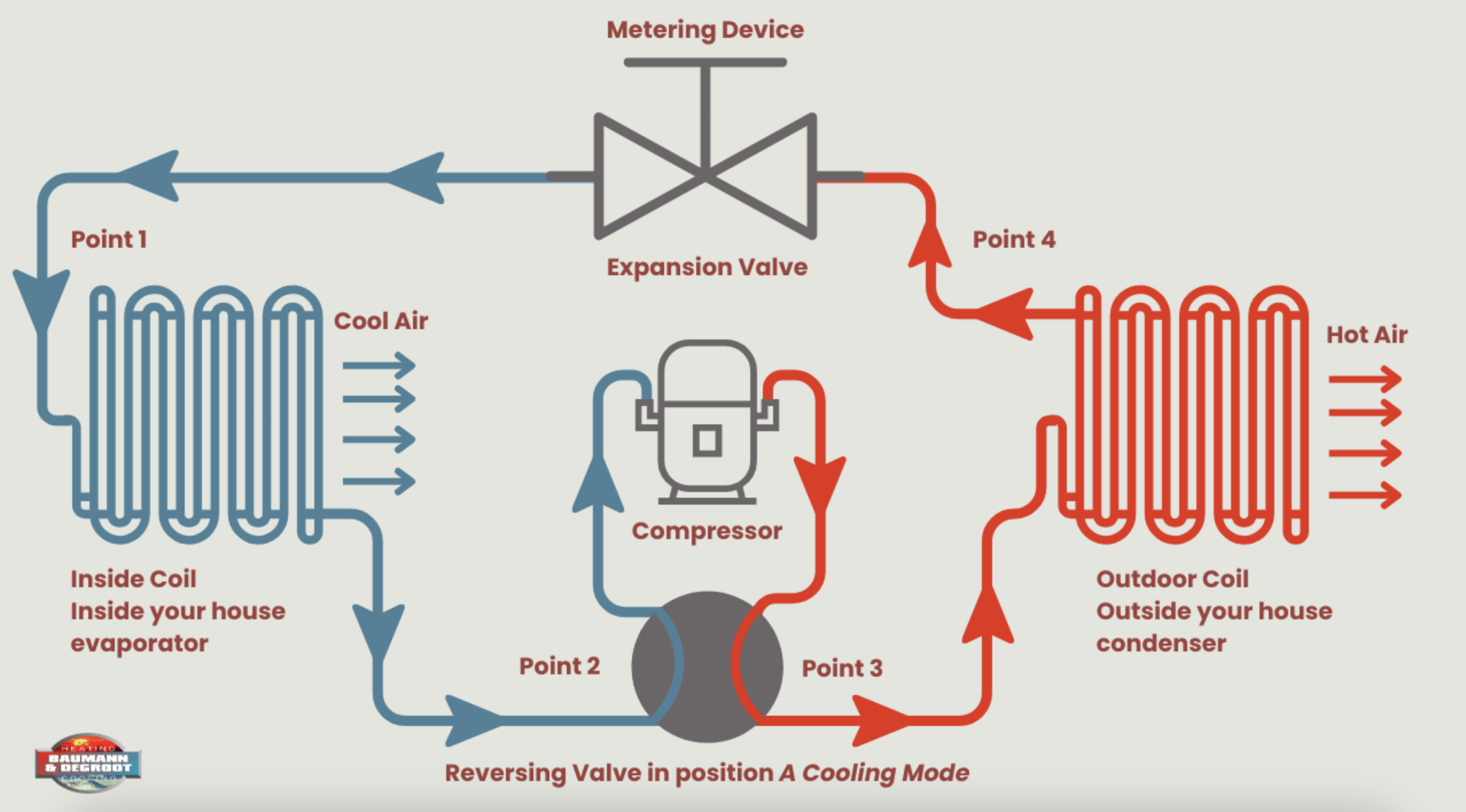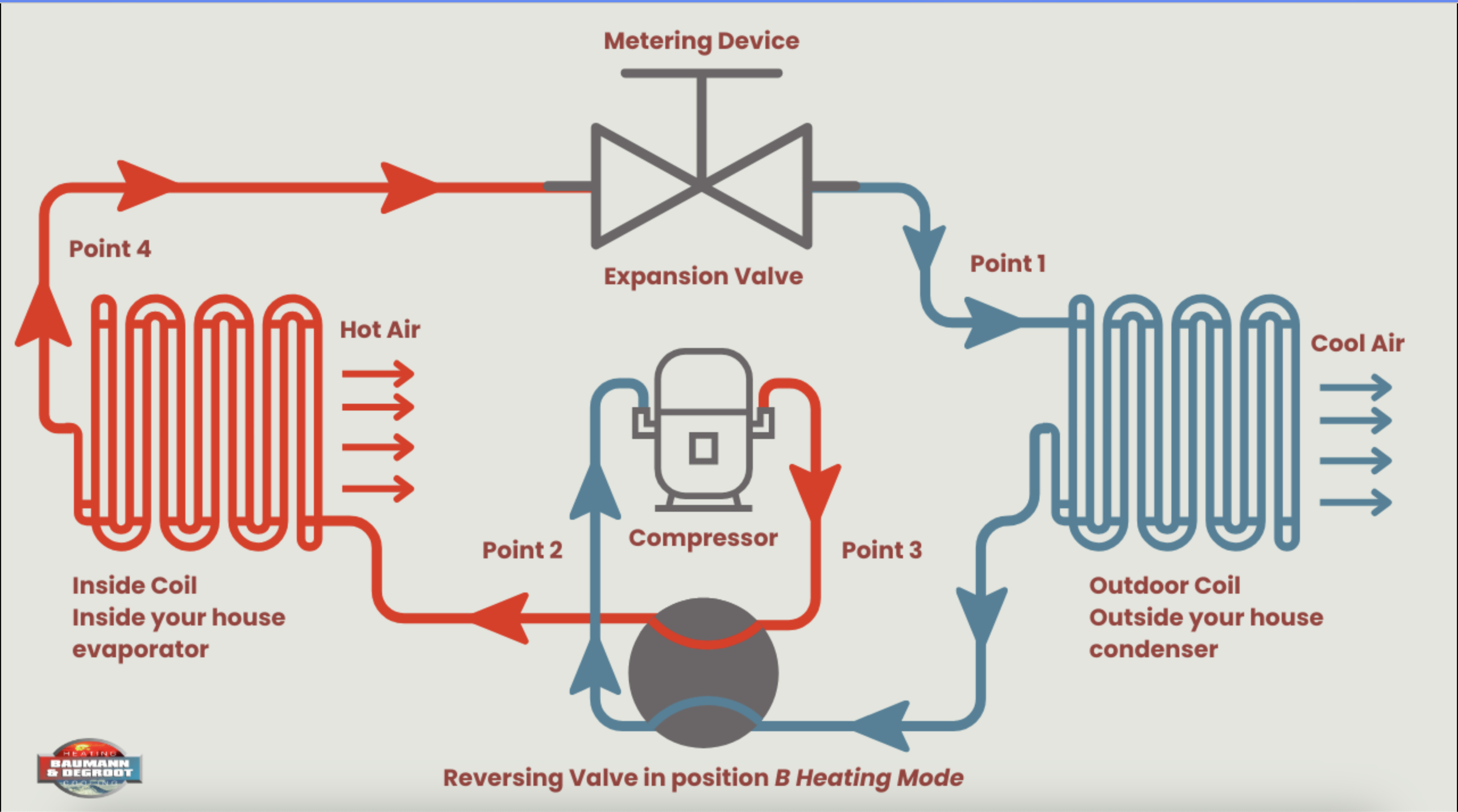Intro to Heat Pump HVAC
Ever wanted to replace your window A/C units with something that’s quieter, more efficient and doesn’t obstruct your windows? Or are you looking to reduce your emissions by reducing your use of gas or oil for heating?
Heat Pumps offer superior energy-efficiency compared to furnaces and air conditioners. You may have seen them at your neighbors’ homes around SOMA. Don’t be fooled by the word “heat” in the name - Heat Pumps can both heat and cool your homes. Like your refrigerator, Heat Pumps use electricity to transfer heat from one space to another. During the cooling season, Heat Pumps move heat from your house to the outdoors, and during the heating season, they move heat (even when it is very cold) from the outdoors into your home. Heat is moved, not generated, saving energy!
Actions you can take right now
If you don’t already have Heat Pumps
If your home is drafty or poorly insulated:
- Visit our Home Weatherization page to address any areas of your home that lose heat quickly in the winter.
- Heat pumps are most efficient when the home is well-insulated with minimal air leakage.
Find incentives and financing options:
- Visit the IRS website for information on tax credits for improving your HVAC system with heat pumps.
- Check out PSEG’s energy efficiency program to learn about 0% financing options available for SOMA residents.
If you have a forced-air central air-conditioning system: Consider replacing your outdoor A/C condenser unit with Heat Pumps to create a dual-fuel system for heating. A system like this can efficiently heat and cool your home, reducing the need to use your furnace, and lower emissions.

Image source: Dual Fuel System Example; Image Source:Global Spec
If you don’t have a forced-air system: Consider a ductless mini-split system for your whole home or for parts of your home. These systems don’t require significant renovations to run ductwork throughout your home. Instead, power lines and thin piping are run into each room from the exterior condenser unit, and each room is equipped with an evaporator unit for custom temperature control.

If you have older Heat Pumps
Consider upgrading your outdoor units to provide greater efficiency and more heat in cold-weather months. Modern systems have higher SEER2 (Seasonal Energy Efficiency Ratio 2) ratings and can help boost efficiency in very cold weather.
How do Heat Pumps work?
There are two main types of Heat Pumps: Air-Source and Ground-Source (Geothermal). Air-Source Heat Pumps are more common, and work well in SOMA’s climate zone. There are ducted systems and ductless ones. The latter is often referred to as “mini-split”, which is highly effective for homes without ductwork — typical of centennial homes in our community.
Source: Rewiring America
The mechanism behind Heat Pumps is heat transfer, leveraging a refrigerant to absorb and release heat as it cycles through the system - similar to how a fridge or A/C works. As the refrigerant moves through the system, it cycles from liquid to gas and back again, absorbing and releasing the heat in the process. You may have heard the names of the system’s components: the Condenser (gas to liquid), the Evaporator (liquid to gas), and the Compressor, which allows the gas to release heat and condense to liquid.
With Heat Pumps, the movement of the refrigerant can be reversed, enabling heat to either enter or leave your home. Because they transfer heat rather than generate heat, Heat Pumps are more energy efficient than other heating and cooling systems.
Air-Source Heat Pump Cooling Mode
During the cooling season, an air-source Heat Pump extracts heat from the indoor air and releases it outside.

Image source: Image Source: Baumann and Degroot
Air-Source Heat Pump Heating Mode
During the heating season, it draws heat from the outdoor air – even in cold weather – and transports the heat indoors.

Image source: Image Source: Baumann and Degroot
Geothermal Heat Pumps
Geothermal Heat Pumps take advantage of the constant temperature of the ground below. In a Geothermal Heat Pump system, the ground absorbs excess heat during summer and provides heat in winter. Relative to the Air-Source type, Geothermal Heat Pumps are more efficient, last longer, need little maintenance, and do not rely on the outdoor air temperature.
What are the benefits of Heat Pumps?
For heating, Heat Pumps can move several times as much energy as they use. Therefore, they use considerably less energy than furnaces, where a tremendous amount of heat energy is lost in exhaust gases. Most new, high-SEER (Seasonal Energy Efficiency Ratio, a measure of efficiency) Heat Pump systems can run at a lower setting for longer periods than less efficient central air systems. This means less extremes in your home when heat comes on and when it is off for a while. They also are better at dehumidification in summer.
Greater efficiency translates to savings on energy bills. Although many factors impact heating and cooling bills, Heat Pumps have the potential to lower them by using less energy to provide the same or better comfort levels. They reduce the need to use gas or oil furnaces exclusively for heat in cold weather months. How quickly your home tends to lose heat during extreme cold temperatures is an important factor in how much you can save. That is why we recommend home weatherization improvements to get the most out of your Heat Pump system.
How much do Heat Pumps cost? Are there government incentives?
As with any home improvement, cost may vary significantly depending on several factors. These may include: your existing type of HVAC system, the Heat Pump model you choose, the size of your home, and the contractor you choose.
If you are adding Heat Pumps to a forced-air system, it could be as simple as swapping your outdoor A/C condenser unit for 1 or 2 Heat Pump units. You may need to upgrade the system controls to accommodate the new equipment. However, this typically doesn’t require major work and can be completed relatively quickly.
Many SOMA homes are heated with steam boilers that transfer heat to the home using radiators. For cooling, many of our homes use window A/C units. For homes like these, there are multiple options:
- A ductless mini-split system for the whole home or for parts of the home. These systems will range in price depending on how large the home is, and whether it is the whole home or just parts of it. Since it is ductless, it doesn’t require renovations related to running large air ducts throughout your home.
- Create a forced-air central HVAC system with Heat Pumps or Geothermal. This will require installing air ducts in your home with an air-handler unit to circulate heated or cooled air. This could require significant renovations throughout your home and added costs for the air-handler unit.
Geothermal systems are even more efficient than air-source Heat Pumps, but add extra costs due to the need to drill into the ground outside your home and install piping to transfer heat to and from the earth. Some configurations include deep vertical holes to access warmer underground layers and provide more efficient heating in the winter. These are extremely efficient systems that have the potential to completely replace a furnace, and therefore significantly reduce energy bills. Other configurations use piping that is horizontal and shallow in your yard, which may require less work compared to a deep vertical pipe, but is not as efficient and may not be feasible for SOMA residents with smaller yards.
There are federal tax credits available. Visit the IRS website for up-to-date information on tax credits for installing Heat Pump systems. Through the end of 2025, the IRS offers:
- Tax credit of up to $2,000 off an air source Heat Pump
- Tax credit of 30% off geothermal heating installation.
For SOMA residents, PSE&G offers several cost-saving options for Heat Pump installations, including:
- 0% financing for 84 months with no credit check, and easy on-bill repayment for qualified energy efficiency upgrades, including Heat Pumps. *In late 2025, PSE&G is offering additional incentives for high-efficiency Heat Pump systems up to $10,000, with even more for low-to-moderate income families.
What can I expect by using Heat Pumps for heating?
We are all familiar with what to expect from a gas or oil-fired furnace. We program our thermostats to have heat turn on and turn off according to our preferred daily schedule. When heat is turned on, the home gets a rush of heat from the radiators or from the registers. The home slowly loses heat, and then the system comes on again when the temperature drops below a certain level.
Heat Pumps are different. They are about efficiency, not about delivering the high power that furnaces can to heat the home. Therefore, the recommendation with Heat Pumps is to keep the home at one temperature all the time. This avoids constant fluctuations in temperature that require significant amounts of energy usage at different times according to your thermostat’s schedule. Keeping your Heat Pumps running all the time may seem wasteful and counterintuitive to saving energy. However, since Heat Pumps are so efficient, it is better for them to “sip” electricity throughout the day than produce high heat at certain points. The result is a constant level of comfort with less energy use. The same is true for cooling.
When temperatures drop below the 20-30°F mark, if your home isn’t well insulated or is drafty, some Heat Pumps may lose their ability to keep your home at a constant temperature. This is because heat loss accelerates when temperatures are extremely cold, and there is less heat available to transfer from the outside. Depending on your desired comfort level indoors, you may decide to have your furnace kick on during days like these. Some systems can accomplish this automatically. Speak with your contractor during installation to decide on the best setup for your home.
Where can I find contractors qualified to install Heat Pumps?
Asking for references from neighbors who have Heat Pumps is a good starting point. PSE&G offers a list of qualified contractors that are affiliated with their Energy Efficiency program to offer financing and rebates.
An increasing number of HVAC contractors in the area are installing Heat Pumps. Ensure contractors accurately analyze your heating and cooling needs to ensure proper sizing of the Heat Pump system. Discuss the setup that meets your particular home’s specifications and your family’s desired level of comfort. If you currently have a forced-air system, your HVAC contractor should be experienced to assess all factors impacting even heating and cooling throughout your home. We recommend you speak with contractors experienced with home weatherization while you are determining your Heat Pump HVAC setup, and take steps to ensure minimal heat loss while your system is in heating mode.
Another option is to check out the websites of top Heat Pump manufacturers, where they list contractors who install their machines. Always ask for multiple quotes, as you would for any home improvement projects!
](https://electrifysoma.org/posts/heat-pump-hvac/cover_img_hvac.png)